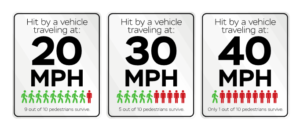 This content is sponsored by DDOT.
This content is sponsored by DDOT.
Earlier this summer, Mayor Muriel Bowser lowered the default speed limit on local streets to 20 mph as part of the District’s ongoing work to reduce the number of pedestrian deaths and injuries in the nation’s capital. “This is a critical step toward safer streets,” said Jeff Marootian, Transportation Director for the District. “The seconds saved by speeding are not worth the price to pay in terms of additional lives lost.”
The default 20 mph speed limit applies to about 60 percent of District streets and smaller roadways that typically have no center line and parking on one or both sides of the road, according to the District Department of Transportation. About 1,400 signs are being replaced to remind drivers of the new speed limit.
Research has shown that the faster motorists are driving on residential streets, the more likely they are to crash and cause death or serious injury to themselves, other drivers or pedestrians.
Pedestrians are less likely to die or be severely injured when hit by a car traveling at a lower speed, according to Metropolitan Police Department data. This data shows that in 2019, 12 pedestrians and two bicyclists were killed in traffic crashes, while over 1,300 were injured, some severely. “Lowering speed limits is a good way to make streets safer for everyone, including pedestrians and bicyclists,” says David Harkey, president of the Insurance Institute for Highway Safety. “Our research has shown that knocking 5 mph off speed limits has a real impact on driver behavior. When drivers slow down, it’s easier for them to avoid crashes, and the crashes that do occur are less severe.”
Speed and stopping distances can mean life and death for a pedestrian. A pedestrian struck by a vehicle at 20 mph has a 90 percent chance of survival. Their chance of survival drops to 50 percent if the vehicle is traveling at 30 mph and to just 10 percent at 40 mph, according to the Federal Highway Administration. These results show the importance of reducing speeds in areas where there is heavy pedestrian traffic.

That’s why the Bowser Administration has determined that 20 is plenty. Across the nation, jurisdictions have prioritized pedestrian safety by lowering the speed limit. Speeding has been a factor in about one-third of all motor vehicle fatalities for more than two decades, according to the National Highway Traffic Safety Administration. District speeding offenses and fines include:
- Speeding up to 10 mph in excess of limit: $50 fine
- Speeding up to 11–15 mph in excess of limit: $100 fine
- Speeding up to 16–20 mph in excess of limit: $150 fine
- Speeding up to 21–25 mph in excess of limit: $200 fine
- Speeding up to 26–30 mph in excess of limit: $300 fine
Statistics show that even small increases in a vehicle’s speed can have deadly results. To put this in perspective, it takes about as long as a football field to stop your car at 55 mph provided the driver is alert. It takes about half of a football field for a car to stop at 30 mph.
Drivers must remember that speed matters. Slow down and look out for pedestrians.
Together we can end pedestrian injuries and deaths. Help make Vision Zero a reality in DC.







